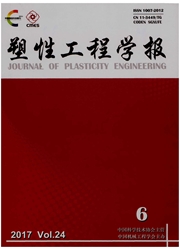

 中文摘要:
中文摘要:
应用非线性有限元软件ABAQUS对平整SLN过程进行二维建模仿真,计算并分析轧辊与带钢间接触摩擦润滑条件、前后张力、压下率、工作辊辊径等工艺参数对平整轧制后带钢厚度方向上纵向残余应力分布的影响。仿真结果表明,轧辊与带钢间接触摩擦润滑条件对带钢厚度方向上的纵向残余应力的分布形式与数值影响很大;压下率与工作辊辊径对带钢厚度方向上的纵向残余应力的数值有一定影响。在轧机前后张力相同时,张力值的大小对带钢厚度方向上的纵向残余应力的分布形式与数值影响很小,可以忽略不计;在轧机前后张力不同时,其差值对带钢厚度方向上的纵向残余应力的数值影响很大,不能忽略。
 英文摘要:
英文摘要:
In this paper, two-dimensional temper rolling process is modeled and analyzed by ABAQUS. The effect of process pa- rameters like contact friction lubrication conditions between work roll and strip, front tension, backward tension, reduction rate and diameter of work roll on the longitudinal residual stress in thickness direction of strip after temper rolling is analyzed. Results are as follows: the effect of contact friction lubrication conditions between work roll and strip on the distribution and numerical value of longitudinal residual stress in thickness direction of strip is significant. Reduction rate and diameter of work roll have a certain influence on the numerical value of longitudinal residual stress in thickness direction of strip. When the front tension and backward tension have the same value, the value has little effect on the distribution and numerical value of longitudinal residual stress in thickness direction of strip. When front tension and backward tension have different values, their difference have a sig- nificant effect on the numerical value of longitudinal residual stress in thickness direction of strip.
 同期刊论文项目
同期刊论文项目
 同项目期刊论文
同项目期刊论文
 期刊信息
期刊信息
